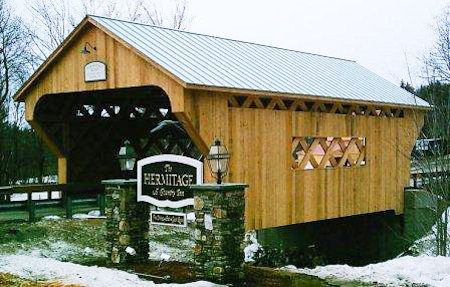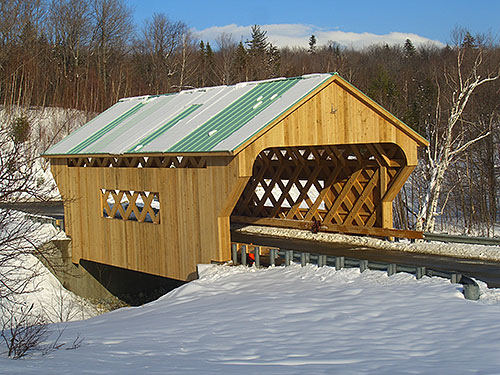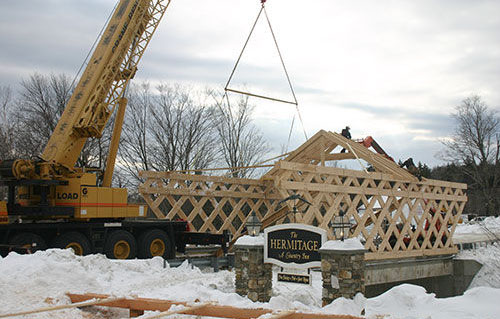
The Hermitage Road Covered Bridge
West Dover Vermont's Newest Landmark
Release Date: Friday, April 3rd 2009

West Dover, Vermont. March, 2009 - Historic covered bridges have long been Vermont's most beloved and eye-catching landmarks, so when a traditionally-built covered bridge suddenly pops up on the landscape, people far and wide take notice. The Hermitage Road Covered Bridge at 25 Handle Road in West Dover, Vermont, is brand new, however, its vintage style keeps it squarely within the proper historical context of Windham County's many National Register covered bridges.
The new bridge, which crosses a pretty mountain stream called Cold Brook, was built over the course of 24 consecutive days in February, 2009. It is the result of remarkable public-private cooperation between the Town of Dover, Vermont and the new owners of the renowned Hermitage Inn. In 1986, the Town completed a wide asphalt-covered concrete span leading from Handle Road onto Hermitage Road, and with what can only be called "wishful thinking," workers included the sets of massive bolts that someone evidently hoped might someday be used to secure a wooden bridge cover.
It was not until this year, however, that the covered bridge was realized, thanks to the generosity of Jim and Donna Barnes, owners of the Hermitage Inn. Their real estate holding corporation funded the entire cost of the wooden bridge for the Town, including the fees for permitting, design planning and engineering as well as the expense of the materials and contractors.
In one sense, the new bridge is already old. It is built in what is called the "Town Lattice Truss" style, a patented timber construction method dating back to 1820. Yale graduate, Ithiel Town (b.1784-d.1844) of Connecticut, popularized the use of an uninterrupted series of closely spaced diagonal timbers for bridges, even improving on his own engineering and filing new patents for the same truss pattern again in 1835. Sometimes called a "garden trellis lattice," the double-pegged crisscross members give bridges that are much longer than the Hermitage Road span considerable strength because the entire structure is stiffened by horizontal "chords," top and bottom. Not surprisingly, Town became wealthy by collecting royalties for the use of his light, easy-to-build truss system.
In Windham County alone, there are numerous Town Lattice Truss covered bridges, including five that are a short drive from the Hermitage Inn: Scott Bridge in Townshend, Williamsville Bridge in Newfane, Green River Bridge in Guilford, Creamery Bridge in Brattleboro, and West Dummerston's covered bridge. The Hermitage Road Covered Bridge is about to be recognized with a listing on the 2009 edition of Vermont's popular covered bridge map and guide.
The timbers in the frame of the Hermitage Road Covered Bridge are Hemlock, logged in Maine. They are pegged with custom 1½" Oak dowels or "trunnels," as they are sometimes called. The bridge is sided with Atlantic White Cedar, which will weather naturally to a silvery gray. The roofing is painted standing-seam steel, a material that is commonly used nowadays even on historic bridges. Based on the traditional construction methods and the durable materials, the low-maintenance cover is expected to endure for centuries to come. No one doubts that it will gracefully age its way into history.
One highly unusual feature of the Hermitage Road Covered Bridge is that it can be removed in one piece should major repairs of the bridge's road bed become necessary. By unbolting the connections holding the wooden cover to the concrete, it can be lifted off by crane. Another uncommon aspect of its design, which was drawn by John Guminak Designs of Dover, is the double row of exposed lattice along both sides-there is a lower "window" at eye level on each side of the span affording framed views of Cold Brook below, and high above, there is a second, longer opening running just under the eave on each side.
During the construction of the wooden cover this past winter, the road below it remained open to traffic at all times. It was the one aspect of the project that was particularly challenging to builder Rob Wadsworth and his 5-man crew from Vermont Barns in Stratton, the contractors who built the bridge. After spending one week pre-assembling two 60 foot-long lattice sides and 31 individual plain and king-post trusses on the snow-covered ground next to the semi-frozen brook, they were able to set the bridge members in place in only one day using the old fashioned "barn-raising" method and a large crane. Once the framework was joined, the contractors squared each angle before adding the roofing and then finishing with the siding and trim over the next two weeks.
The new covered bridge, which is easily seen from Handle Road, forms a gateway onto the 100-acre private estate of the Hermitage Inn. Steven O'Hern, the general manager, expects that since the bridge is in such a scenic setting, the Inn's guests and passersby will quickly realize that it is one of the region's most photogenic landmarks. In autumn, the scenery behind the covered bridge and along the banks of Cold Brook will be ablaze in colorful fall foliage; all spring and summer the bridge will be cocooned by the lush green of the surrounding fields and forest; and in winter, the snowy white ski slopes of nearby Haystack Resort will be visible above the roof peak.
According to town records, the new covered bridge does not replace any prior covered bridge over Cold Brook at this spot. Satellite photos of the area seem to be several years out of date, so the covered bridge is not currently visible on sites such as Google Earth.
Innkeeper Steven O'Hern is available for interviews and further comment by email at innkeeper@hermitageinn.com or by calling the Inn at (802) 464-3511. He is pleased to provide travel writers and editors with additional photography and information about the new Hermitage Road Covered Bridge and the historic Hermitage Inn.



